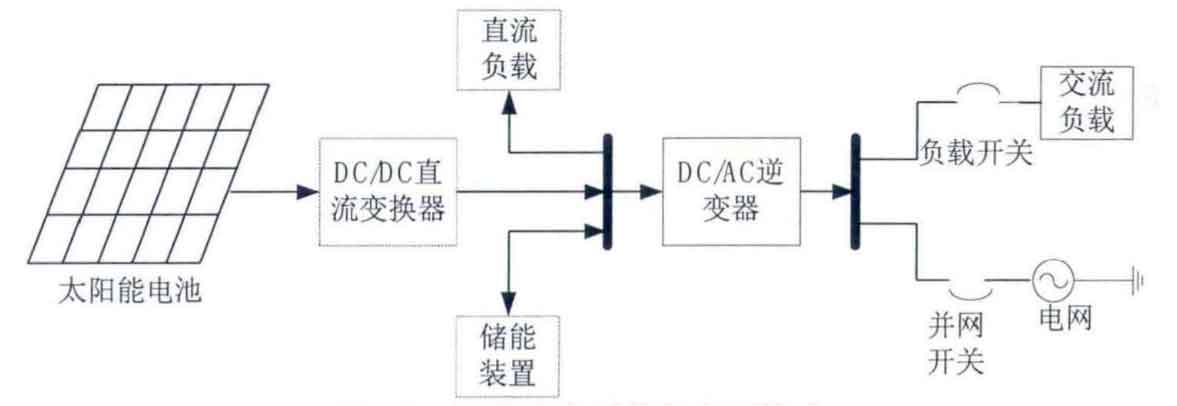1. Structure of solar photovoltaic power generation system
Solar photovoltaic power generation systems can be divided into many structures based on their functions, mainly independent solar photovoltaic power generation systems and grid connected solar photovoltaic power generation systems. According to the load type, application mode, and application scale of the system, it can be divided into several different systems, mainly small solar photovoltaic power supply systems, simple DC systems, AC/DC systems, grid connected systems, grid connected hybrid systems, and hybrid power supply systems. Its main components are shown in the figure, including solar cells and matrices, power conversion (including inverters and chargers), solar photovoltaic power generation system control system, energy storage system, and load.

Solar photovoltaic power generation systems can directly supply power to DC loads, as well as transmit power to the grid or supply power to AC loads. The output voltage of solar photovoltaic systems that directly supply power to DC loads is relatively low. The voltage needs to be adjusted by a DC converter and then connected to the DC bus, which is then connected to a DC/AC inverter to convert it into AC power and supply it to AC loads or transmit it to the grid. Solar photovoltaic power generation systems can be applied in many different situations, and different functions can be achieved by flexibly changing the configuration. In addition, the energy storage device can also be directly connected to the DC bus, which can control the flow of power and allocate energy reasonably. In the case of insufficient energy in solar photovoltaic cells, energy storage devices can also supply electricity to the load or output electricity to the grid, which is equivalent to an uninterrupted power supply. However, in practical applications, the volume and cost of energy storage devices can also have a certain impact on their power generation systems.
2. Centralized solar photovoltaic grid connected power generation system
According to the properties of solar photovoltaic grid connected power generation systems, solar photovoltaic grid connected power generation systems are divided into two types: centralized and distributed power generation systems. Among them, centralized is considered a solar photovoltaic power station, with a maximum power exceeding tens of megawatts and a very large output voltage, which can be connected to high-voltage or medium voltage transmission lines without the use of transformers.
During its initial use, most of its grid connected capacity was generated through centralized power generation. The way to produce electricity is to use a large number of solar cells for circuit connection, which generates a relatively high voltage. Finally, the electricity is transmitted to the grid through a very large capacity solar photovoltaic grid connected inverter. However, this method is not very comprehensive:
(1) When transmitting power to the grid, only high-voltage cables can be used to connect solar photovoltaic cells and inverter devices together.
(2) The subtle differences between each battery group will affect the maximum load point tracking of the centralized power generation system.
(3) Solar photovoltaic equipment generates significant energy consumption.
3. Distributed solar photovoltaic grid connected power generation system
At present, the power network is mainly composed of large units, large-scale grid, and high-voltage single power supply systems. The contradiction between the shortage of conventional fossil fuels and rapid economic development has become increasingly prominent, and the shortcomings of the “centralized power supply structure” power system have been exposed, The centralized power supply structure of the power supply system can no longer meet the increasingly high demand for power supply quality and safety economy. The development of distributed power generation has injected new vitality into the traditional centralized power supply structure.
The solar photovoltaic modules that transform solar photovoltaic into grid connected power generation systems on the distribution side are called distributed solar photovoltaic grid connected systems. This system is located next to the customer, allowing energy to be directly used and connected to the power network at a voltage level of 10KV or lower. The total installed capacity of each public connection point in each power generation project must be less than 6MW, and the total installed capacity of each public connection point on the 220V distribution side is less than 8kV. Distributed solar photovoltaic power generation systems can be used in areas where the sun is shining, such as rooftops, land surfaces, and the upper part of street signs. Most of the projects installed on the top of buildings are distributed solar photovoltaic power generation projects, which can be used in eligible places such as campuses, buildings, and factories.
